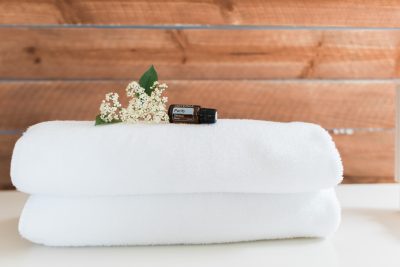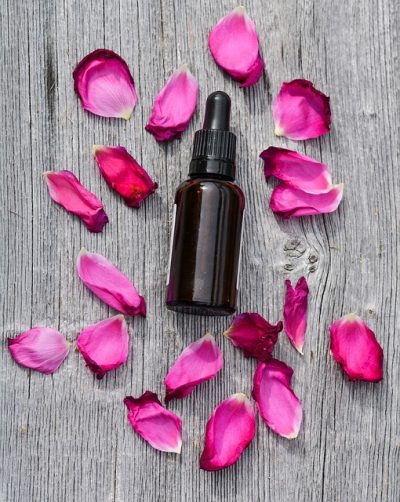A certified aromatherapist’s view on essential oils for mums & bubs
It is fantastic that the use of essential oils as a low tox and natural approach to wellness has gained popularity in recent times. However with the rise in sales through MLM companies, comes the spread of health information through untrained product distributors and as a health professional I find this disturbing.
So I invited certified local aromatherapist Zoë, owner of Divine and Pure Wellness, to write a guest blog on safe use of essential oils for mums, bubs and kids. Here is a comprehensive guide for any mum who wants to enjoy oils in a safe way.

What are essential oils?
Essential oils are the fragrant and highly concentrated natural constituents found in some plants. They are extracted from various parts of a plant, such as the: roots, stems, seeds, bark, flowers and peel.
Each essential oil has unique volatile aromatic compounds, which determine its distinctive aroma and therapeutic benefits that can be used to support the human body physically and emotionally.
Pregnant women, new mums and children can all be supported by the use of specific 100% pure essential oils and aromatherapy, when used safely and conservatively.
Below are a few of my favourite essential oils and examples of how they can increase your wellness during this new and exciting time in your life.

5 wonderful essential oils for pregnancy
• Copaiba (Copaifera langsdorfii, Copaifera officinalis) – ask your partner to use this in a massage for muscle aches in your back, neck or legs.
• Geranium (Pelargonium graveolens) – use topically for swelling of the legs and ankles.
• Lavender (Lavandula angustifolia) – use topically in a moisturiser after your shower for stretch marks.
• Patchouli (Pogostemon cablin) – diffuse during meditation for grounding and balancing your emotions.
• Tea Tree (Melaleuca alternifolia) – put 1 drop on a cotton ball and inhale to support the immune system.
5 wonderful essential oils for postpartum
• Chamomile, German/Roman (Chamaemelum nobile, Matricaria recutita) – use topically on the soles of your feet to promote deep sleep.
• Geranium (Pelargonium graveolens) – use topically in massage oil to soothe cracked nipples.
• Lemon (Citrus x limon) – use in a bath with Epsom salts to boost your energy.
• Lime (Citrus x aurantifolia) – put 3 drops on a cotton ball and use in the car to increase concentration.
• Orange, Sweet (Citrus sinensis) – use in your diffuser when you wake up to uplift your mood.
5 wonderful oils for young children
• Frankincense (Boswellia carteri) – diffuse to support the immune system.
• Lavender (Lavandula angustifolia) – diffuse to promote deep sleep.
• Lemon (Citrus x limon) – diffuse to support the respiratory system.
• Mandarin (Citrus reticulata) – diffuse to uplift your child’s mood.
• Vetiver (Vetiveria zizanoides) – diffuse to promote relaxation.
*It is important to note that each of the essential oils listed above have numerous other therapeutic benefits and application methods.

Application tips
• The safest way to experience essential oils during this time is by inhalation. Only 3 drops are needed when using a high quality essential oil in a diffuser.
For children under 2 years of age, I always recommend using a diffuser over topical use.
• It is considered safe to use some essential oils during the second and third trimester of pregnancy. However, if you have a history of complications or are considered a high-risk pregnancy it is recommended not to use essential oils until the third trimester or postpartum.
• Applying topically to the soles of the feet is one of the safest and most effective places to use your essential oils.
• If applying topically always dilute the essential oil to a 1% dilution rate or less when pregnant and breastfeeding (1 drop of essential oil per 1 teaspoon of carrier oil).
• Topical application for children should be diluted further and used only when necessary, as diffusing is the safest option. A 0.25% dilution is recommended for children that are 6 months to 2 years old (1 drop of essential oil per 4 teaspoons of carrier oil).
• A 0.5% dilution is recommended in topical use for children that are 2 to 6 years old (1 drop of essential oil per 2 teaspoons of carrier oil).
• Slowly introduce essential oils to babies. Only one essential oil should be used per day.
Children and pregnant / breastfeeding women should never ingest essential oils.
• Never use essential oils in the birthing pool.
• When purchasing essential oils always check the Latin name and ensure they contain no synthetic fragrances.
• Some essential oils can react with the sun (phototoxic) and must be applied at least 12 to 24 hours before spending time outside. For example: Angelica, Bergamot, German Chamomile, Grapefruit, Lemon, Lime, Mandarin and Tangerine.
Please refer to the lists below to find out specific essential oils that are considered safe and unsafe during pregnancy, breastfeeding and childhood. These lists are not exhaustive and it is important to do your own research before using any essential oil.
Essential oils to AVOID during pregnancy and breastfeeding
• Aniseed (Pimpinella anisum)
• Anise, Star (Illicium verum)
• Araucaria (Neocallitropsis pancheri)
• Artemisia (Artemisia vestita)
• Atractylis (Atractylylodes lancea)
• Birch (Betula lenta)
• Black Seed (Nigella sativa)
• Buchu (Agathosma betulina, Agathosma crenulata)
• Calamint (Calamintha nepeta)
• Camphor (Cinnamomum camphora)
• Carrot Seed (Daucus carota)
• Cassia (Cinnamomum cassia)
• Chaste Tree (Vitex ugnus castus)
• Cinnamon Bark (Cinnamomum verum)
• Cypress, Blue (Callitris intratopica)
• Dill Seed (Anethum graveolens)
• Eucalyptus, ALL (Eucalyptus camaldulensis, Eucalyptus globulus, Eucalyptus maidenii, Eucalyptus plenissima, Eucalyptus kochii, Eucalyptus polybractea, Eucalyptus radiata, Eucalyptus autraliana, Eucalyptus phellandra, Eucalyptus smithi)
• Fennel, Bitter/Sweet (Foeniculum vulgare)
• Feverfew (Tanacetum parthenium)
• Genipi (Artemisia genepi)
• Hibawood (Thujopsis dolobratta)
• Ho Leaf (Cinnamomum camphora)
• Hyssop (Hyssopus officinalis)
• Lanyuna (Artemisia afra)
• Lavender, French/Spanish (Lavandula stoechas)
• Lemongrass (Cymbopogon flexuosus)*
• May Chang (Litsea cubeba)*
• Mugwort (Artemisia arborescens, Artemisia vulgaris)
• Myrrh (Commiphora myrrha)
• Myrtle Backhousia anisata)
• Myrtle, Lemon (Backhousia citriodora)*
• Nutmeg (Mysristica fragrans)
• Oregano (Origanum onites, Origanum smyrnaeum, Origanum vulgare, etc.)
• Parsley, Leaf/Seed (Petroslinum sativum)
• Pennyroyal (Mentha pulegium)
• Plectranthus (Plectranthus fruticosus)
• Rosemary (Rosmarinus officinalis)
• Rue (Ruta graveolens)
• Sage, Spanish (Salvia lavandulaefolia)
• Tansy (Tanacetum vulgare)
• Tea Tree, Lemon (Leptospermum petersonii)
• Thuja (Thuja occidentalis)
• Western Red Cedar (Thuja plicata)
• Wintergreen (Gaultheria procumbens)
• Wormwood (Artemisia absinthium)
• Yarrow (Achillea millefolium, Achillea nobilis)
• Zeodary (Curcuma sedoaria)
* Avoid during pregnancy / okay while breastfeeding when used in a diffuser or diluted correctly.
Essential oils that are considered SAFE during pregnancy and breastfeeding
• Bergamot (Citrus bergamia)
• Black Pepper (Piper nigrum)
• Chamomile, German/Roman (Chamaemelum nobile, Matricaria recutita)
• Copaiba (Copaifera langsdorfii, Copaifera officinalis)
• Coriander (Coriandrum sativum)
• Cypress (Cupressus sempervirens)
• Fir Needle (Abies alba, Abies sachalinensis, Abies sibirica)
• Frankincense (Boswellia carteri, Boswellia frereana, Boswellia neglecta, Boswellia rivae, Boswellia sacra, Boswellia serrata)
• Geranium (Pelargonium graveolens)
• Ginger (Zingiber officinale)
• Grapefruit (Citrus x paradisi)
• Juniper berry (Juniperus communis)
• Lavender (Lavandula angustifolia)
• Lemon (Citrus x limon)
• Lime (Citrus x aurantifolia)
• Mandarin (Citrus reticulata)
• Neroli (Citrus x aurantium)
• Orange, Sweet (Citrus sinensis)
• Patchouli (Pogostemon cablin)
• Pine, Scots (Pinus sylvestris)
• Rosewood (Aniba rosaeodora)
• Sandalwood (Santalum spicatum)
• Spruce, Norway (Picea abies)
• Tangerine (Citrus reticulata)
• Tea Tree (Melaleuca alternifolia)
• Ylang Ylang (Cananga odorata)

Essential oils considered SAFE for children 6 months to 2 years of age
These essential oils are considered safe for use in a diffuser. Topical use should always be diluted correctly and used only when necessary.
• Bergamot (Citrus bergamia)
• Cedarwood, Atlas/Virgina (Cedrus atlantica, Cedrus deodora, Juniperus virginiana)
• Chamomile, German/Roman (Chamaemelum nobile, Matricaria recutita)
• Copaiba (Copaifera langsdorfii, Copaifera officinalis)
• Coriander (Coriandrum sativum)
• Cypress (Cupressus sempervirens)
• Frankincense (Boswellia carteri, Boswellia frereana, Boswellia neglecta, Boswellia rivae, Boswellia sacra, Boswellia serrata)
• Geranium (Pelargonium graveolens)
• Ginger (Zingiber officinale)
• Grapefruit (Citrus x paradisi)
• Juniper Berry (Juniperus communis)
• Lavender (Lavandula angustifolia)
• Lemon (Citrus x limon)
• Mandarin (Citrus reticulata)
• Marjoram, Sweet (Marjorana hortensis)
• Neroli (Citrus x aurantium)
• Orange, Sweet (Citrus sinensis)
• Patchouli (Pogostemon cablin)
• Sandalwood (Santalum spicatum)
• Tangerine (Citrus reticulata)
• Tea Tree (Melaleuca alternifolia)
• Vetiver (Vetiveria zizanoides)
Essential oils children should AVOID until 6 or 10 years of age
• Peppermint essential oil is safe for children over 6 years of age.
• All types of eucalyptus and rosemary should not be used unless your child is over 10 years of age.
Need more support?
Hi beautiful soul, I’m Zoë the owner of Divine and Pure Wellness. I am a certified Aromatherapist and Holistic Wellness Coach that is passionate about helping women boost their energy naturally. As every woman and child is unique the above suggestions are to be used as a guide only. Please contact me at divineandpureperth@gmail.com for more information about how I can support you or follow me on Instagram @pertharomatherapist and @divineandpure for more wellness tips!
Disclaimer:
The Therapeutic Goods Administration has not evaluated the information shared in this blog post. Essential oils are not intended to diagnose, treat, cure or prevent disease. The information provided here is the personal opinion of me and should not substitute your own research or medical advice from a licensed medical professional.




